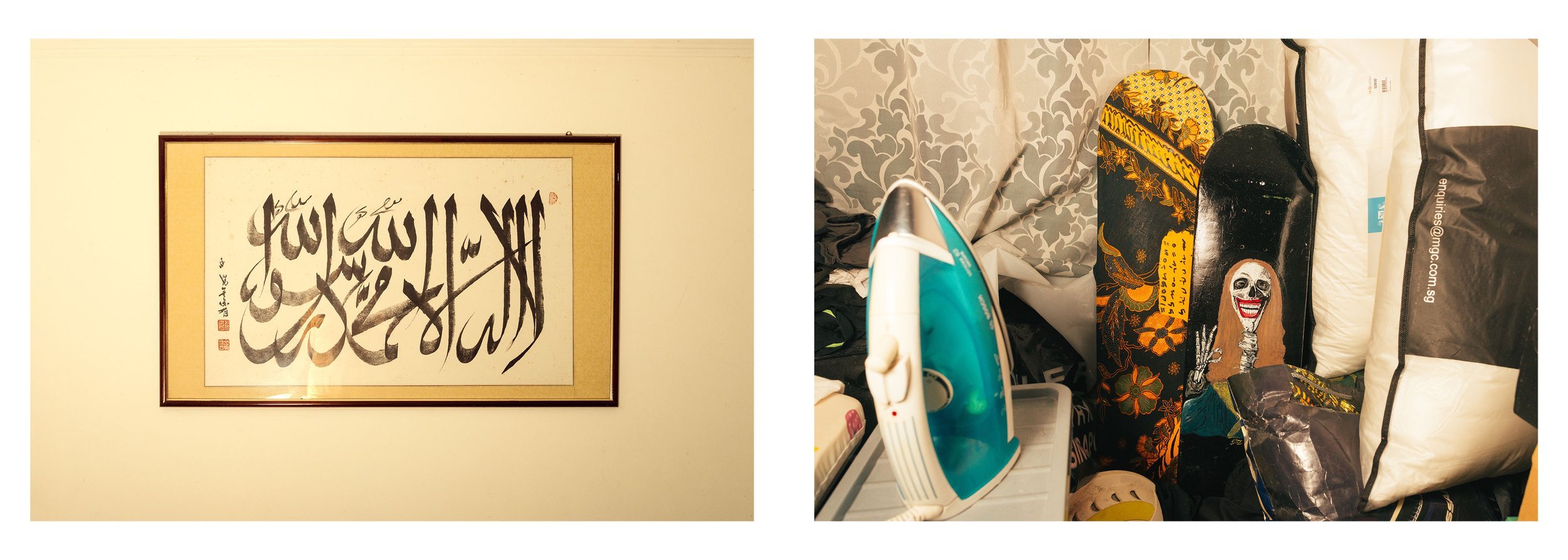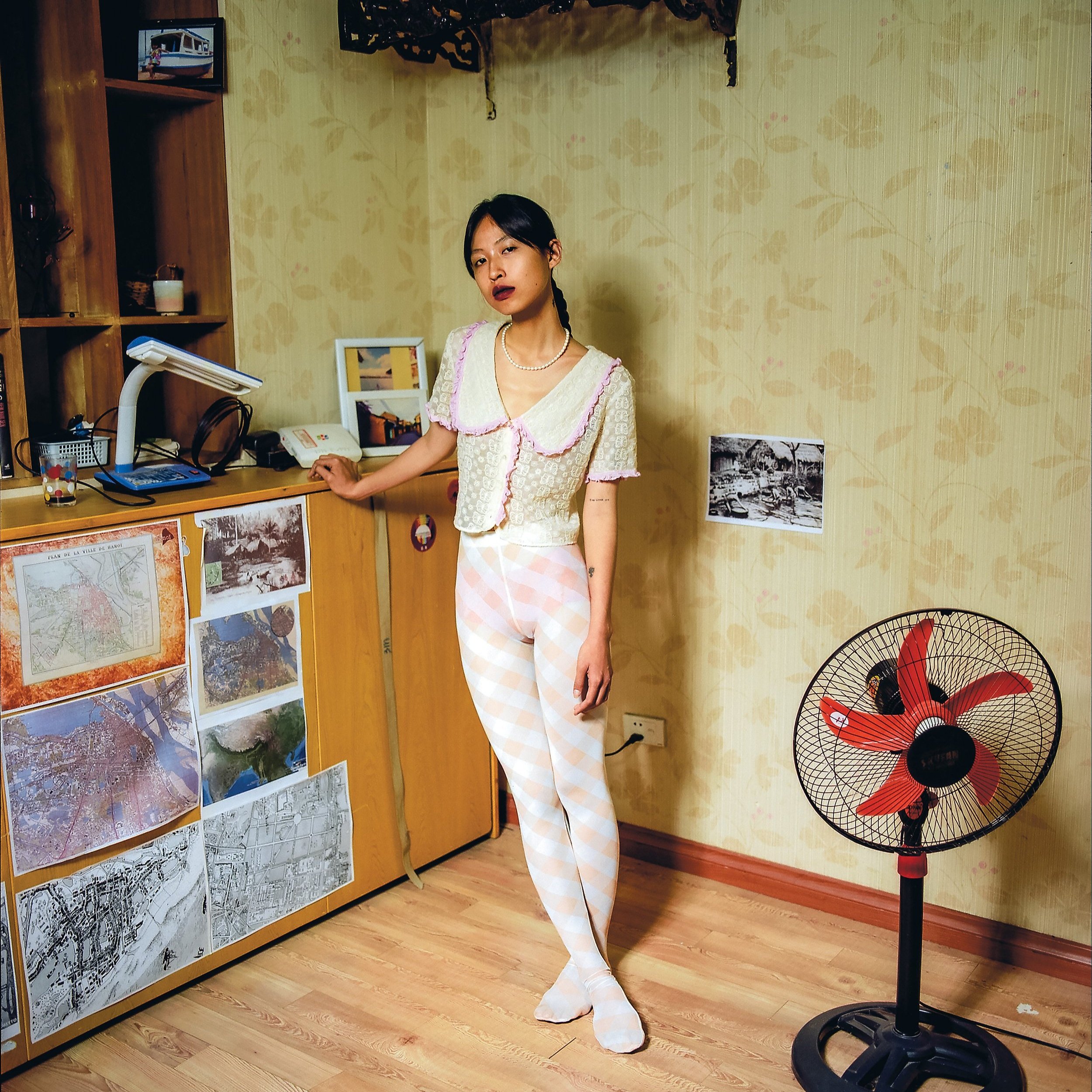Through the Lens: Jaya Khidir
Singapore Malay male identity in home portraits
By Woong Soak Teng
‘Through the Lens’ is a series that explores in detail images from fashion image-makers in Southeast Asia, shining a light on their creative and technical processes.
Jaya Khidir, page 71 of ‘YALAM’. Erwin Shah, a graphic design graduate dressed in baju keluar, one of the “fashion situations” given by the artist to his collaborators. Image courtesy of the artist.
Jaya Khidir is a Singapore-based photographer whose image-making practice intersects with fashion and socio-political commentary. A graduate from the BA(Hons) Fashion Media and Industries programme at LASALLE College of the Arts with prior training at film school, Jaya’s visual language exists between still and moving images, fashion and film and aesthetic and cultural realms.
Jaya Khidir, pages 205 and 206 of ‘YALAM’. Left: Wafy, a fashion media student, is pictured eating a pineapple tart that is commonly served during Hari Raya whilst he is dressed in baju keluar or clothes for leisure outings. Right: A collection of fish specimens gathered by the father of another collaborator. Collecting fish as pets is a popular hobby amongst many in the Malay community due to their historical relationship with the seas and its culture closely associated with seafaring and fishing. Images courtesy of the artist.
His latest project, ‘YALAM’, combines home portraits, environmental observations, newspaper clippings and interviews into an extensive and surprisingly intimate publication that reflects upon the Singapore Malay identity from the perspective of a cisgender Malay man.
Could you describe this photo series and the resulting print publication?
The ‘YALAM’ series in its current form, subtitled ‘volume one’, is a 452-page book featuring 30 cis-gender male Malay individual youths aged 16 to 30 years old taken in their homes. The fashion, art, furniture and other objects documented in the book gives the reader clues about each individual's Malay identity. The word ‘YALAM’ is a mirror image of the word Malay. The title of the work draws inspiration from a slur that became commonly used amongst the youths in the early 2010s. I hope to reclaim the use of this word by referencing the reflexivity of the Malay identity that is caught between adapting to a globalised majority society and sticking with communal ethnic traditions.
What is the concept behind it and how did you arrive at this theme?
The concept behind it was purely out of necessity. I could not find visual documentation of contemporary Singaporean Malay identity. I arrived at this theme whilst I was writing a thesis paper about interpreting this identity through the perspective of object-oriented ontology as formulated by Graham Harman. Sociologists Lily Zubaidah Rahim and Syed Hussein Alatas who write about the Malay community have also influenced my practice.
The research and writing process gave me the courage to try and articulate those written ideas in my own visual practice. The overarching theme is the concept of "withdrawal" as posited by Harman where he holds that objects are independent not only of other objects, but also from the qualities they animate at any specific spatiotemporal location. Growing up, I had to present different versions of myself according to the spaces I was in, whether it was in front of my parents or my friends who were from other races.
“Growing up, I had to present different versions of myself according to the spaces I was in, whether it was in front of my parents or my friends who were from other races.”
Jaya Khidir, page 110 of ‘YALAM’. Haze, a skateboarding coach, is putting on a metal earring. Metallic accessories such as chains, bracelets and rings are popular amongst Malay males in order to present a metrosexual and masculine image. Image courtesy of the artist.
Jaya Khidir, page 325 of ‘YALAM’. Shaiful, a wedding photographer, is pictured in his baju rumah or home clothes, playfully filming a scene with a Super 8 camera. He is seen wearing a white top with idiosyncratic prints of various fruits, together with a traditional sarong in brown fabric. Image courtesy of the artist.
Speaking to other Malays in the community, I found that this was a common psychological experience for Malay-Muslim youths. I wanted to visually articulate a specific relationality between Malay personhood and the homes they live in, where it could be read as alienating but also at the same time comfortable. This documentation directs the gaze towards the lived experience amongst Malay youths who grow up navigating contradictory ideologies mainly stemming from postmodern, secular Singapore, folk cultural tradition and religious orthodoxy.
Jaya Khidir, pages 39 and 40 of ‘YALAM’. Left: A 5-room HDB flat in Jurong West, where a sizeable population of Malay residents moved to, from various neighbouring islands such as Pulau Semakau. Right: A newspaper extract from New Nation on 19 May 1971. Images courtesy of the artist.
How did you begin the image-making process?
I asked each of the person I documented to interpret four situations in terms of the clothes that they would wear:
baju rumah (home clothes)
baju keluar (clothes for leisure outings)
baju kenduri (clothes for attending functions)
baju kerja (clothes for going to work)
Decades of archived newspapers dating all the way back to 1895 also inform the reader about socio-political moments experienced by the local Malay community, which indirectly affected the documentation of Malay youths. This non-linear book is designed to alternate between recent imagery and decades old textual archives.
You started out as a film student before going into fashion media and harnessing photography as your main medium. Why did you eventually choose to work with the medium of photography and to expand your photography into a print publication?
I find the medium of photography being the most accessible in terms of relaying visual cues and ideas to the general public. The copious amount of documentation collected throughout the process was distilled into a book form, which serves as a visual guide for readers to help them think and reflect about the ever-changing contemporary Malay Singaporean identity.
Jaya Khidir, page 419 of ‘YALAM’. Dani, a barber who cuts hair for customers in his room. This is his usual work attire. Image courtesy of the artist.
Jaya Khidir, pages 11 and 12 of ‘YALAM’. Left: The framed object bears the Arabic inscription of the shahada, an Islamic oath whispered to the ear of a newborn Muslim child or to be recited when one converts to Islam. The inscription is done in the style of Chinese calligraphy. These forms of framed inscriptions were popular and ubiquitious in the homes of Malay-Muslim families in the early 2000s. Right: The skateboard object is made by fellow Singaporean Malay artist, Fairuz Jaafar. The text found in the skateboard is written in an ancient form of Malay which reads, “I am weeping, calling you. Though I called, you do not come.” Images courtesy of the artist.
How does fashion shape the identity of cisgender Malay males in Singapore and how is this reflected in your portraits in the series?
Fashion influences come in myriad ways when they interact with cisgender Malay males in Singapore, at least the ones I have personally documented. It has to do with the pervasive presence of television, internet and social media. Western subcultures associated with punks, mods, hip-hop, skaters, and drag have gone global and are particularly popular with cisgender Malay youth.
For better or for worse, and perhaps due to a lack of alternatives, the popular mode of dressing is influenced by Western negotiations of fashion identities, regardless of one’s race. I wanted to highlight the visual contradictions and slippages in the Malay identity, by portraying the individuals in their traditional outfits in contrast to the usual clothes they wear, which are informed by Western subcultures. I hope that when readers go through the book, they see that there is more than one way of looking at a person.
“I hope that when readers go through the book, they see that there is more than one way of looking at a person.”
Jaya Khidir, pages 283 and 284 of ‘YALAM’. Left: Mikhail frequently dresses in non-binary ways whenever he goes out for shopping or to hang out with friends. Right: A painting of a woman on the wall. Images courtesy of the artist.
Did you work with a team or collaborators in this project? How has the collaborative process been?
The subjects were my collaborators. I documented a total of 50 individuals. It was liberating because I had no expectations of them, other than the fact that they had to be in their homes whilst I photographed them, and they did not have any expectations of me either. The second volume focuses on the cisgender female identity, which is still a work in progress.
Which fashion photographer’s work has inspired you most in the making of 'YALAM'?
I would say Bill Cunningham, Nan Goldin and Khalik Allah had varying degrees of influence on me whilst working on ‘YALAM’.
See more of Jaya's works on Instagram at @jaya.khidir.



















